Neat rows of tulips bloom in the gardens of Colonial Williamsburg.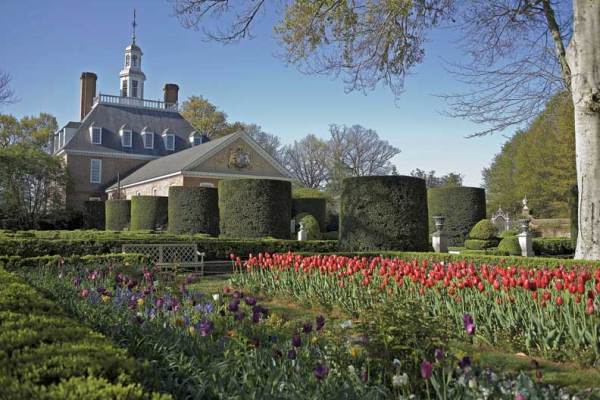
It’s a well-known fact that artists draw inspiration from travel; new scenery, new people, and new cultures all heavily influence artistic impression. So it stands to reason that we gardeners—who are, at our most basic, “plant artists”—would benefit from changing vistas as well.
And it’s true. Over years of private travel, and then during five years as host of The Victory Garden on PBS, I’ve had marvelous opportunities to visit gardens all over the globe, and many have heavily influenced not only my own landscape, but also how I design gardens for my clients. Transoceanic flights, however, are not necessarily required. Here are three of my favorite gardens in the United States with some very important lessons to teach.
The Getty Villa in Malibu, California
The Getty Villa in Malibu connects the indoors and out through courtyard gardens (Photo: Juergen Nogai & Julius Shulman/©2006 J. Paul Getty Trust)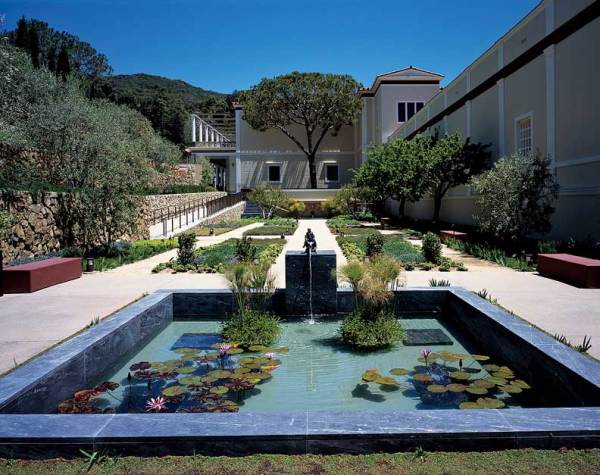
To my mind, one of the most remarkable landscapes in the United States, perhaps the most remarkable, surrounds the Getty Villa in Malibu. For those of you unfamiliar with the place, the Villa, constructed by oil magnet J. Paul Getty in the 1970s, is an exact replica of the Villa of the Papyri in Herculaneum, which was buried by the eruption of Mt. Vesuvius in AD 79. (The original villa, which still remains largely entombed in hardened volcanic rock, was excavated and mapped by tunneling during the 19th and 20th centuries.)
The Getty structure, which steps down its sloping seaside site, is probably humanity’s best guess at what Roman gardens looked like. In neat, box-lined beds, ancient herbs and flowers bloom, surrounding bronze sculptures and punctuated by flowing fountains. Along the colonnaded walls, frescoes of country scenes and imaginary landscapes blur the distinction between architecture, garden, and the hilltops beyond. While the scale of the garden is immense and outside the range of anyone except multimillionaires, the take-away lesson here is simple and applicable to almost any garden: link indoors and out. What strikes the visitor immediately is how gracefully the Getty gardens flow in, out, and around the structure, and how the house returns the gesture, embracing the gardens within its walls.
The Getty Villa gardens reflect what a true Roman garden may have looked like. (Photo: Ellen Rosenbery/©2005 J. Paul Getty Trust)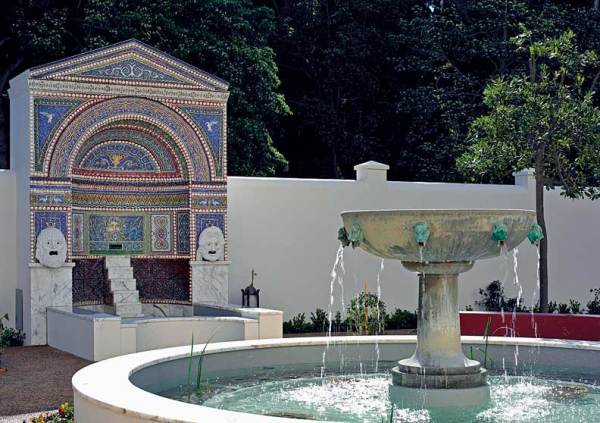
Now granted, not all of us are blessed with a Mediterranean climate like that found in Malibu, but many are, and even in these places, modern construction is rarely successful in uniting house and garden the way the Getty Villa does. Each time I visit the Getty, I return to my own New England garden and work on ways to improve how I see the garden from within, and how the garden sees the house from without. (The Getty is now split into two separate sites. The old villa in Malibu, which houses its extensive classical collections, and the new museum, strikingly situated on a hill overlooking all of L.A. and surrounded by modern gardens of great beauty. Both are well worth the trip. More information on visiting is at getty.edu/visit.)
The Gardens of Colonial Williamsburg
The product of another oil magnate, this time John D. Rockefeller, Jr., the gardens that surround the restored homes and shops of Colonial Williamsburg provide an entirely different type of lesson for the garden traveler. In many ways, these small, enclosed cutting gardens are far more accessible to the modern visitor than the grand scale of the Getty. In fact, they aren’t too terribly dissimilar from the quarter-acre lots that surround homes all over the nation.
Colonial Williamsburg has a number of orderly cutting gardens enclosed by boxwood hedges.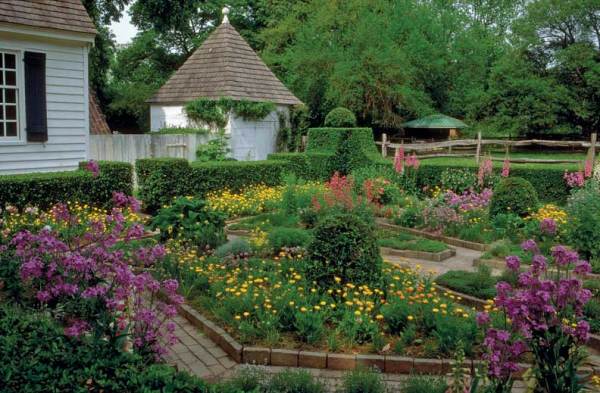
What sets them apart from their modern brethren, however, is their sense of order and unity. Tour the various gardens of Williamsburg (and there are dozens), and in each you’ll be struck by how harmonious the relationship is between the various architectural features, the plantings, and the homes themselves. Fences, whose design derives from some element of the house architecture, move out in orderly lines from the house and then conclude in logical ending points, so unlike many of today’s ill-conceived fence lines. Hardscape elements—walkways, arbors, trellises—share common materials and colors. And the plantings, so different from the messy masses that surround today’s homes, are in scale with the structures, and related to them by axial lines.
In short, these gardens are comfortable—not to mention comforting—to spend time in, and my visits to Williamsburg have taught me always to be aware that when laying out a garden, the house needs to be the starting point for any design. So many landscapes today are conceived as if the house didn’t really matter, when in fact, it’s the style of the house, the color of the house, the situation of the house, and the access to the house that must dictate the elements of the design. Think about it: Without a house, you’re landscaping a field. It’s the house that drives the garden, not vice-versa, and that’s a lesson easily appreciated in Colonial Williamsburg. (More information at history.org.)
Dumbarton Oaks in Washington, D.C.
Beatrix Farrand designed the original gardens at Dumbarton Oaks. (Photo: Karl Gercens)
Just a few hours away from Williamsburg, and a just a few miles from the Capitol, sits one of the most magnificent gardens on the eastern seaboard: Dumbarton Oaks. Designed by the renowned landscape architect Beatrix Farrand for owners Mildred and Robert Woods Bliss in the 1920s as their country home, the property now belongs to Harvard University and the federal government, who work jointly to preserve the 20-odd acres of gardens.
Of course, when visiting a garden created by a true genius like Farrand, it would be easy to take away any number of well-taught lessons, and Dumbarton Oaks doesn’t disappoint. Clever aerial hedges surround grassy walks, custom-designed furniture nestles among native plantings, terraced gardens lead down from the lovely Georgian home. But what strikes me as a professional designer is not so much what was accomplished—the Blisses, after all, were millionaires who could have instructed Farrand to create whatever style of garden they wished—but rather what wasn’t. The house is located on difficult, hilly terrain that borders Rock Creek (emphasis on rock), and instead of leveling vast stretches and clearing immense vistas to create a classical layout, Farrand worked within the constraints of nature, nestling garden rooms into the hillsides and connecting them with forested walks.
The Dumbarton Oaks gardens in Washington, D.C, meld with their natural setting. (Photo: Karl Gercens)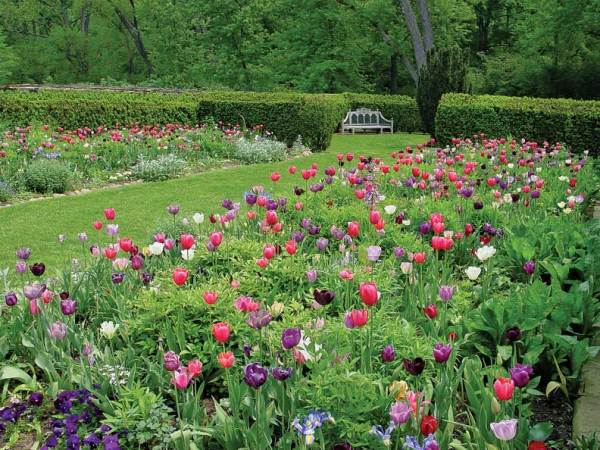
That’s not to say the undertaking still wasn’t immense, but the garden plan works with nature in a way that few modern landscapes do. (One other success that immediately comes to mind is Frank Lloyd Wright’s Taliesin, in Spring Green, Wisconsin.) The take-away concept here is that whatever your site or climate, gardens succeed best when they coexist with their surroundings, rather than attempt to dominate or control them. Dumbarton Oaks reminds us to embrace whatever conditions we’ve inherited—sun, shade, bog, desert—and make the most of them. (More information at doaks.org/gardens.)
So this summer, wherever your travels take you, do yourself a favor: Bring along a camera, a small notebook, and spend some time visiting gardens. You, and your backyard, will be glad you did.
Need help figuring out what to plant in your garden? See our list of the best hydrangeas for historic gardens.
Landscape designer and PBS horticultural guru Michael Weishan gardens outside Boston and writes a nationally acclaimed weekly garden blog at michaelweishan.com.







